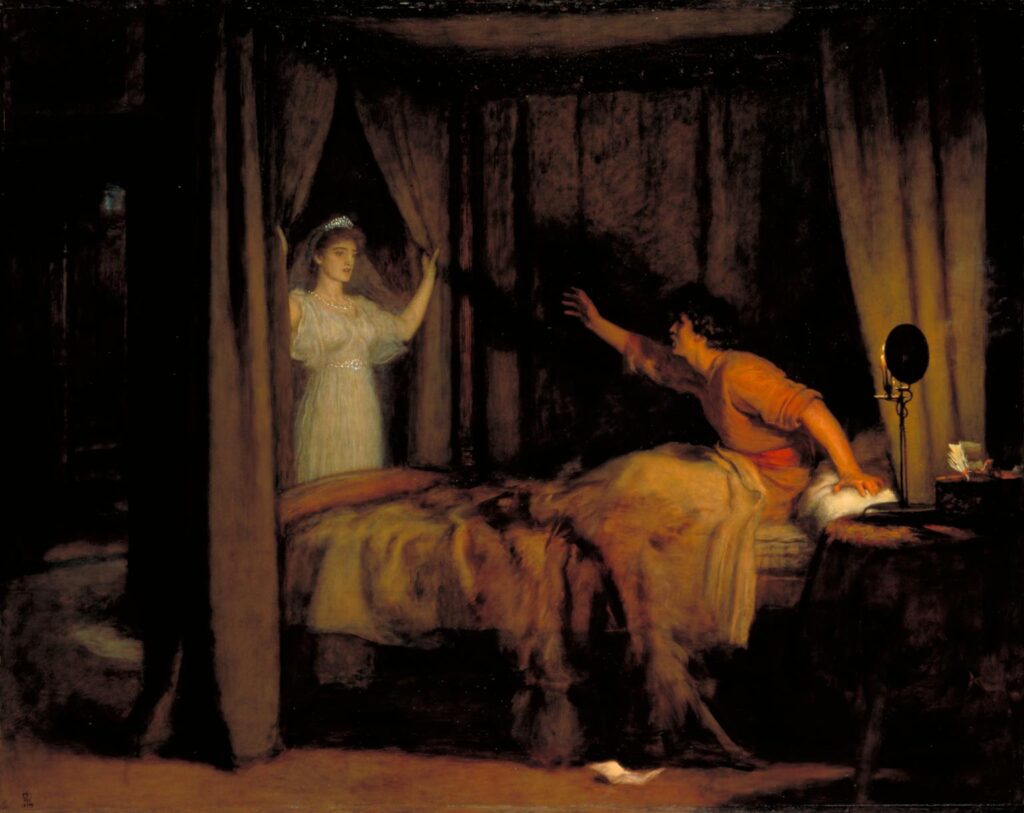Reading Visual Art: 191 Curtains of concealment and revelation

Curtains, drapes of fabric suspended from rails or lines, have been around a long time, but have only recently become popular for providing an internal screen for windows. Although they have other purposes in paintings, they’re primarily used to conceal or to reveal when drawn back. Unusually, they can be depicted as part of the content of a picture, or added to it as a deception, a trompe l’oeil, to fool the viewer into thinking the curtain isn’t in the picture, but is real.
It was Raphael who was probably the first painter to attempt a trompe l’oeil using curtains, in his Sistine Madonna from 1512-13.
Raphael (1483–1520), Sistine Madonna (1512-13), oil on canvas, 265 x 196 cm, Gemäldegalerie Alte Meister, Staatliche Kunstsammlungen Dresden, Dresden, Germany. Wikimedia Commons.
Now recognised as one of Raphael’s greatest and most important paintings, it was donated by Pope Julius II to the Benedictine basilica of San Sisto in Piacenza. The two saints shown are Saint Sixtus II and Saint Barbara, whose relics were preserved there. The Madonna and saints are painted superbly, but it’s the rest of the image that is most fascinating. The two cherubs with tousled hair at its foot are gentle touches of humour for a congregation as they looked at this image.
But Raphael’s visual feat is the curtains. He was by now confident that his realism was sufficient to pull off a trompe l’oeil, and fool the viewer into thinking that they were looking at a painting behind real curtains, at least until they got close. Having fooled them once, they’re now more receptive to the image beyond the curtains.
Those curtains also have theological significance: they mark the separation between the physical and spiritual worlds. As they are painted and not real, though, access through them is always open. No one can come along, draw them closed, and stop the ordinary person from accessing Christ. In a world where almost everything else, apart from air, was heavily controlled, this was and remains an empowering message.
Oleksandr Murashko (1875–1919), Annunciation (1907-08), oil on canvas, 198 x 169 cm, National Art Museum of Ukraine Національний художній музей України, Kyiv, Ukraine. Wikimedia Commons.
Curtains are bold moves in some other religious paintings, including Oleksandr Murashko’s breathtaking Annunciation from 1907-08. Apparently, he was first inspired to paint this when he saw a girl part light curtains to enter his house from the terrace outside, and saw a parallel with the entry of the Archangel Gabriel in the Annunciation.
Dante Gabriel Rossetti (1828–1882), The Girlhood of Mary Virgin (1848–9), oil on canvas, 83.2 x 65.4 cm, The Tate Gallery (Bequeathed by Lady Jekyll 1937), London. © The Tate Gallery and Photographic Rights © Tate (2016), CC-BY-NC-ND 3.0 (Unported), http://www.tate.org.uk/art/artworks/rossetti-the-girlhood-of-mary-virgin-n04872
Their role in Dante Gabriel Rossetti’s Girlhood of Mary Virgin from 1848–9 is less convincing. This contains some archaic devices, such as the gilt and lettered halos, and an oddly-proportioned angel, but shows what Rossetti envisaged might have been the pictorial reality of the Virgin Mary during her youth. She works on embroidery with her mother, Saint Anne, while her father, Saint Joachim, prunes a vine. Those are shown realistically with an abundance of symbolic objects, but the curtains seem merely a background.
Raphaelle Peale (1774–1825), Venus Rising From the Sea – A Deception (c 1822), oil on canvas, 74 x 61.3 cm, Nelson-Atkins Museum of Art, Kansas City, MO. Wikimedia Commons.
A curtain formed from an outsized handkerchief is concealing in Raphaelle Peale’s Venus Rising From the Sea – A Deception (c 1822). This was a visual criticism of the small-minded attitude to the display of paintings of nudes at the time.
With curtains concealing what shouldn’t be seen, they provide a means for the voyeur to peep through them.
Lovis Corinth (1858–1925), Susanna Bathing (Susanna and the Elders) (1890), oil on canvas, 159 x 111.8 cm, Private collection. Wikimedia Commons.
The story of Susanna (or Shoshana) and the Elders is told in the Old Testament book of Daniel, chapter 13, and centres on voyeurism, blackmail, and justice. Susanna was a beautiful married woman who was bathing in her garden one afternoon, having dismissed her servants. Two lustful elders spied on her, and as she returned to her house they stopped her, and threatened that, unless she agreed to have sex with them, they would claim that she had met her lover in the garden. Being virtuous, Susanna refused their blackmail, and was promptly arrested, charged with promiscuity, and awaited her execution.
It was only after the intervention of the young prophet Daniel that the elders’ conspiracy was revealed, Susanna was acquitted of the charge, and the elders executed instead. Lovis Corinth’s early Susanna Bathing from 1890 adopts a traditional approach, where Susanna is seen in the flesh, being spied on by a peeping elder from behind a curtain.
Pedro Américo (1843–1905), Faust and Gretchen (1875-80), oil on canvas, 34 x 23 cm, Pinacoteca do Estado de São Paulo, São Paulo, Brazil. Wikimedia Commons.
Pedro Américo’s Faust and Gretchen from 1875-80 uses this in the context of the seduction of Gretchen in Goethe’s Faust. The shadowy figure of Mephistopheles is eavesdropping behind the curtain at the right, and white lilies, a symbol of her virginity, lie fallen on the floor.
While peeping is implicitly non-consensual and unwelcome, curtains can also be used for revelation.
John Everett Millais (1829–1896), Speak! Speak! (1895), oil on canvas, 167.6 x 210.8 cm, The Tate Gallery (Presented by the Trustees of the Chantrey Bequest 1895), London. © The Tate Gallery and Photographic Rights © Tate (2016), CC-BY-NC-ND 3.0 (Unported), http://www.tate.org.uk/art/artworks/millais-speak-speak-n01584
One of Millais’ last paintings, before his death the following year, was Speak! Speak! (1895), which is also one of his most enigmatic. Millais’ son reported that this scene is set in ancient Rome. The young man had spent much of the night reading through the letters of his lost love. At dawn, the curtains were parted to reveal her, dressed for her bridal night, gazing upon him with sad but loving eyes. The title of the painting is therefore the words that he said to her spectre.
The mere presence of curtains denotes separation, particularly that between performers and their spectators.
Antoine Watteau (1684–1721), The Italian Comedians (c 1720), oil on canvas, 63.8 x 76.2 cm, National Gallery of Art, Washington, DC. Wikimedia Commons.
Antoine Watteau adds a scarlet curtain both for colour and as the conventional separator between The Italian Comedians (1720) and their audience.
Ludwig Knaus (1829–1910), Behind the Curtain (1880), oil on mahogany wood, 81 x 110 cm, Galerie Neue Meister, Dresden, Germany. Wikimedia Commons.
Ludwig Knaus shows the scene Behind the Curtain of a small itinerant circus in 1880. Performers were often colourful in both their costume and character, with many incongruities, such as the clown seen in the centre feeding a baby, and looking straight at the viewer. Their curtain is also rough and ready.
Grant Wood (1891–1942), Parson Weems’s Fable (1939), oil on canvas, dimensions not known, Amon Carter Museum of American Art, Fort Worth, TX. Wikimedia Commons.
Grant Wood’s Parson Weems’s Fable from 1939 refers to Mason Locke Weems (1759-1825), who wrote the first biography of George Washington shortly after the latter’s death. This contains several apocryphal stories, including the legend of the cherry tree, which didn’t appear until its fifth edition.
According to this, when Washington was six, he was given custody of a hatchet, which he used to cut through the bark of a superb young English cherry tree. When this was discovered the next day, Washington’s father asked the boy if he knew who had killed the cherry tree, to which George Washington admitted his guilt, saying that he couldn’t tell a lie. His father was overjoyed at his son’s honesty. Sadly, the story is generally considered to be a fabrication.
Wood’s ingenious treatment places Parson Weems at the right, holding open a stage curtain, as if narrating the story to the viewer.




